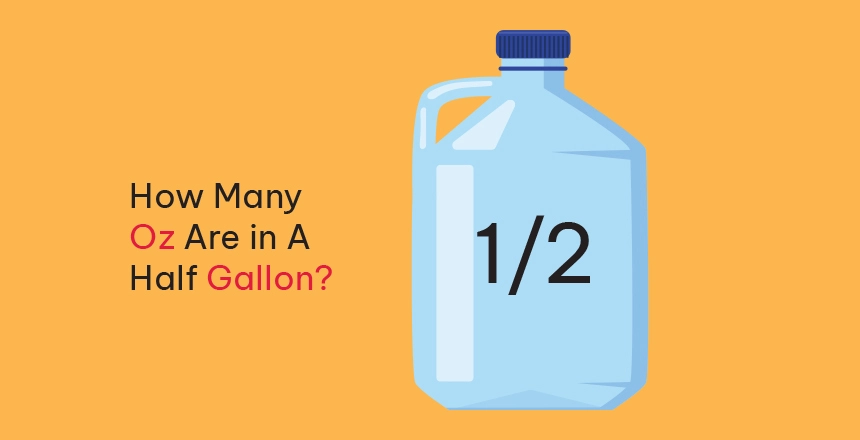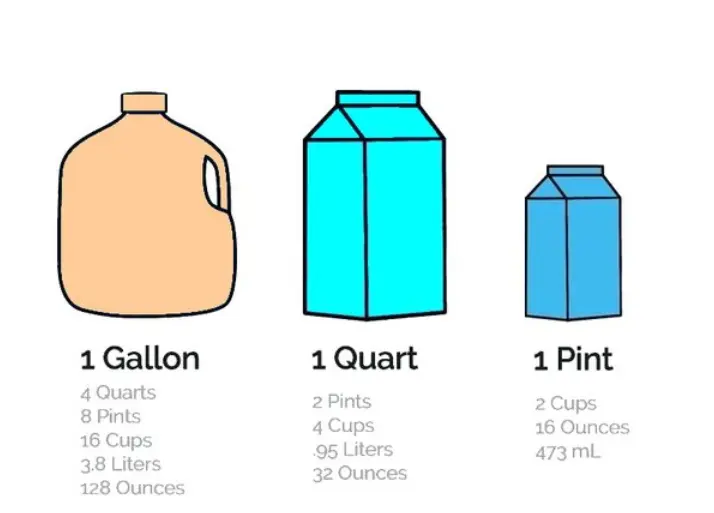Learn how many ounces in half gallon and unravel the mysteries of fluid conversions. This comprehensive guide explores the relationship between ounces and half gallons, providing insights into fluid ounces, cups, pints, quarts, and gallons. Say goodbye to confusion and master fluid measurements today.
Table of Contents
ToggleIntroduction
When it comes to fluid measurements, understanding the conversion between different units can be quite confusing. One common question that often arises is, “How many ounces are there in a half gallon?” In this article, we will delve into this topic and provide you with a comprehensive understanding of fluid measurements, specifically focusing on the conversion between ounces and half gallons. Whether you’re a culinary enthusiast, a DIY enthusiast, or simply curious about fluid measurements, this article is here to shed light on this common query. So let’s dive right in!
How Many Ounces in Half Gallon?
To determine how many ounces are in a half gallon, we need to establish the conversion factor between the two units. A gallon is a widely used unit of measurement in the United States, while ounces are commonly used for smaller quantities.
In the United States, a gallon consists of 128 fluid ounces. Therefore, to find out how many ounces are in a half gallon, we need to divide the number of ounces in a gallon by two. Applying this calculation, we find that there are 64 ounces in a half gallon.
Understanding Fluid Measurements
Fluid measurements are crucial in various aspects of our lives, including cooking, baking, crafting, and more. It is essential to grasp the different units of measurement and understand how they relate to one another. Let’s explore some common fluid measurement units and their conversions.
Fluid Ounces (fl oz)
Fluid ounces, commonly abbreviated as “fl oz,” are a widely used unit for measuring liquids. They are typically used for smaller quantities and are an essential part of many recipes. One fluid ounce is equivalent to approximately 29.57 milliliters (ml). To put this into perspective, a standard small water bottle usually contains 16.9 fluid ounces.
Cups
Cups are another commonly used unit of measurement in the culinary world. They provide a convenient way to measure liquids, especially in recipes. One cup is equivalent to 8 fluid ounces. It’s important to note that cups are often used interchangeably with fluid ounces in recipes, making it crucial to understand the relationship between the two.
Pints
A pint is a larger unit of measurement compared to cups and fluid ounces. It is commonly used in the United States and the United Kingdom. In the United States, a pint consists of 16 fluid ounces, while in the United Kingdom, it contains 20 fluid ounces.
Quarts
Quarts are a step up from pints in the fluid measurement hierarchy. In the United States, a quart contains 32 fluid ounces, while in the United Kingdom, it contains 40 fluid ounces.
Gallons
Gallons are the largest unit of fluid measurement we commonly encounter. They are often used for large quantities of liquids, such as milk or water. As mentioned earlier, a gallon consists of 128 fluid ounces in the United States and 160 fluid ounces in the United Kingdom.
Conversion Table
To help you visualize the relationship between different fluid measurement units, here is a conversion table:
| Fluid Measurements | Fluid Ounces (fl oz) |
|---|---|
| 1 Cup | 8 fl oz |
| 1 Pint | 16 fl oz |
| 1 Quart | 32 fl oz |
| 1 Gallon (US) | 128 fl oz |
| 1 Gallon (UK) | 160 fl oz |
Now that we have a better understanding of fluid measurements let’s delve deeper into some frequently asked questions about the conversion between ounces and half gallons.
The Importance of Accurate Fluid Measurements
Accurate fluid measurements play a crucial role in various aspects of our daily lives. Whether you’re a professional chef crafting culinary masterpieces or a home cook preparing a family meal, precision in measuring liquids is vital for achieving the desired results. In addition, accurate fluid measurements are essential in fields such as chemistry, pharmacy, mixology, and DIY projects.
Cooking and Baking
In the culinary world, precise measurements of liquids are critical for creating perfectly balanced flavors and textures. Imagine baking a cake and mistakenly adding too much or too little liquid. The outcome could be disastrous—a dry, crumbly cake or an overly moist and dense one. By understanding fluid measurements and converting between ounces and half gallons, you can ensure your recipes turn out just right.
Mixology and Bartending
Mixologists and bartenders rely on accurate fluid measurements to create delicious cocktails with the perfect balance of flavors. Whether it’s a classic Martini, a refreshing Mojito, or a complex Tiki cocktail, precision in measuring the different components is key. The right proportions of spirits, mixers, and garnishes can elevate a drink from ordinary to extraordinary. By mastering fluid measurements, you can become a skilled mixologist, impressing your friends and guests with your cocktail creations.
DIY Projects and Crafting
Fluid measurements extend beyond the culinary realm and find their place in various DIY projects and crafting endeavors. Whether you’re mixing paints for a home renovation project, creating handmade soaps or candles, or even working on automotive repairs, accurate measurements are essential. Incorrect fluid proportions can lead to subpar results, affecting the quality and outcome of your project. By understanding fluid measurements, you can confidently measure and mix liquids, ensuring the success of your DIY endeavors.
Scientific and Pharmaceutical Applications
In scientific research, laboratory experiments, and pharmaceutical manufacturing, precise fluid measurements are of utmost importance. Researchers rely on accurate measurements to ensure the reliability and reproducibility of their experiments. Pharmaceutical companies meticulously measure and mix ingredients in specific quantities to produce medications with consistent potency and efficacy. Any deviation in fluid measurements can have significant implications, potentially compromising the accuracy and reliability of scientific studies or the safety and effectiveness of medications.
Everyday Life
Even in our day-to-day activities, fluid measurements play a role. From measuring the water-to-coffee ratio for that perfect cup of morning brew to accurately measuring the amount of laundry detergent needed for a load of clothes, fluid measurements are part of our routines. Understanding the conversion between ounces and half gallons allows us to make precise measurements, avoiding waste or insufficient quantities.
Accurate fluid measurements are the backbone of successful culinary endeavors, scientific research, DIY projects, and everyday activities. By grasping the concept of fluid measurements and mastering the conversion between ounces and half gallons, you can confidently tackle any task that involves liquids. So next time you reach for that measuring cup or need to convert between fluid ounces and half gallons, remember the importance of accuracy and the impact it can have on your desired outcome.
FAQs about the Conversion between Ounces and Half Gallons
1. How can I convert ounces to half gallons?
Converting ounces to half gallons is a straightforward process. Simply divide the number of ounces by 64 to get the equivalent in half gallons. For example, if you have 128 ounces, dividing it by 64 would yield 2 half gallons.
2. Can I use a measuring cup to measure half a gallon of liquid?
Measuring cups are designed for smaller quantities and may not be suitable for measuring half a gallon accurately. To measure half a gallon, it is recommended to use a larger container, such as a gallon pitcher, marked with appropriate measurements.
3. How many ounces are there in a quart?
In the United States, a quart contains 32 fluid ounces. Therefore, if you have a quart and would like to convert it to ounces, you can multiply the number of quarts by 32 to obtain the equivalent in ounces.
4. Is the conversion factor for fluid ounces and half gallons the same worldwide?
No, the conversion factor for fluid ounces and half gallons may vary depending on the country. In the United States, one gallon equals 128 fluid ounces, resulting in 64 fluid ounces in a half gallon. However, in the United Kingdom, a gallon contains 160 fluid ounces, which means a half gallon would be 80 fluid ounces.
5. What are some common examples of half gallon containers?
Half gallon containers are frequently used for storing and selling liquids. Some common examples include half gallon milk jugs, juice containers, and ice cream tubs.
6. How can I accurately measure a half gallon of liquid without a half gallon container?
If you don’t have a half gallon container, you can use a quart container and measure out two quarts to obtain a half gallon. Remember, one quart is equivalent to 32 fluid ounces, so two quarts would give you 64 fluid ounces, which is the equivalent of a half gallon.
Now that we have answered some common questions regarding the conversion between ounces and half gallons, let’s summarize our findings.
7.If I have any further questions or need assistance, how can I contact you?
If you have any questions or need assistance, please feel free to reach out to our knowledgeable team. You can contact us through the provided contact form on our website. We are here to help!
Conclusion
Understanding fluid measurements, especially when it comes to converting between different units, is essential in various aspects of our lives. In this article, we explored the question, “How many ounces in a half gallon?” We discovered that there are 64 ounces in a half gallon in the United States, while the conversion factor varies in other countries such as the United Kingdom. We also explored the relationship between fluid ounces, cups, pints, quarts, and gallons, providing a comprehensive understanding of fluid measurements.
Next time you come across a recipe that calls for a half gallon or need to measure liquids accurately, you can confidently convert between ounces and half gallons. So go ahead and explore the culinary world, embark on DIY projects, or simply satisfy your curiosity with the knowledge gained from this article.
Remember, the key to mastering fluid measurements lies in practice and familiarity. By understanding the conversion factors and having the right tools at hand, you can confidently tackle any fluid measurement task that comes your way.


